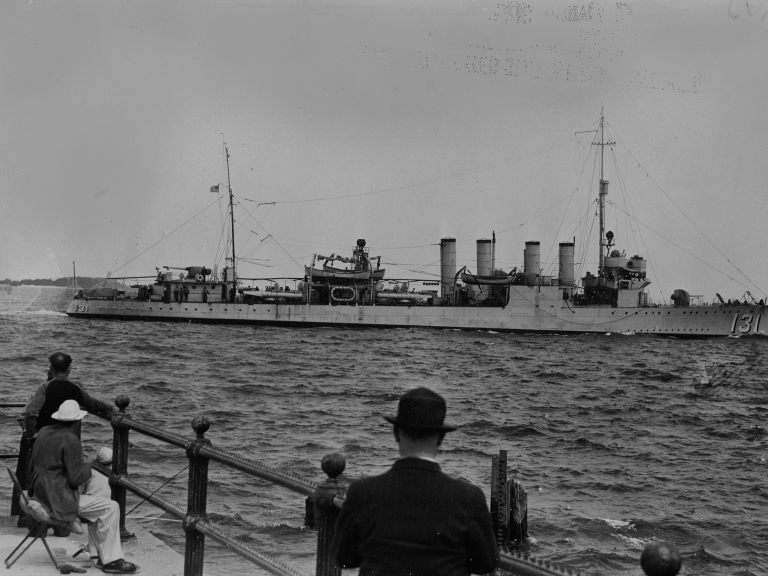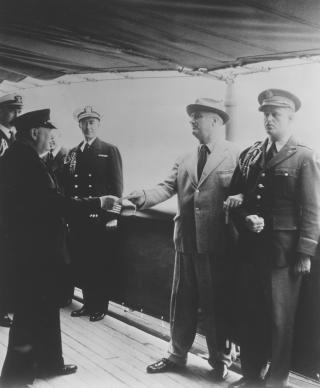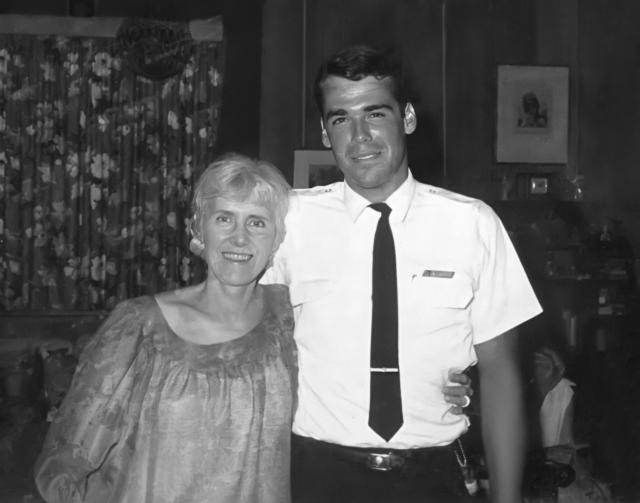
U.S.S. Buchanan, one of six destroyers leaving Boston for delivery to London in 1940, under Lend-Lease. Photo: U.S. Naval Institute.
Naval History Magazine of the U.S. Naval Institute
By Captain Michael A. Lilly, U.S. Navy (Retired)
Before U.S. entry into World War II, a deal was made to avail England of U.S. destroyers then in mothballs—but it took some crafty manipulation of the famous Time-Life publisher and his equally famous wife to make it happen.
Washington, D.C. In 1981, my grandmother Una Walker asked me to deliver several germinating coconut trees to her lifelong friend, the famed writer and editor Clare Boothe Luce (widow of Henry “Harry” Luce, the pioneering publisher of Time, Life, and other magazines). Clare was living at her Kahala beach house on the island of Oahu. At that time, Clare revealed to me that, back in the early days of World War II, she and Harry’s unwitting participation in a tale of international manipulation and intrigue involving the Lend‑Lease plan had helped save England from Hitler.
Clare’s maid answered my knock and ushered me to a small alcove overlooking a pool and spacious lawn. Soon, I heard Clare’s cultured voice behind me: “Well, Michael . . .”
I turned to see Clare—then in her senior years, but elegant and dynamic. Her skin was flawless, “translucent as a pearl” as one author put it. There was very little about her that suggested her age. She was graceful and beautiful.
“Come kiss your Auntie Clare,” she said with her arms outstretched. “Don’t you look marvelous. If I recall correctly, the last time we were together, you caught me a lobster for lunch.”

“Yes, I remember catching it for you.” As I grew up, Clare frequently stayed at my grandparents’ beach home, “Muliwai,” on the north shore of Oahu. It had been Fleet Admiral Chester W. Nimitz’s weekend hideaway during the Pacific war.
After exchanging pleasantries, Clare settled back and said that, under then-President Ronald Reagan, “I’ve finally got my old job back. I’m on the President’s Foreign Intelligence Advisory Board—a sort of secret, hush‑hush group of people that reviews intelligence information. We make recommendations to the President. I had the job under [President Richard] Nixon. Then I was out under that pitiful [Jimmy] Carter. And now I am back again.”
Clare had a remarkable ability to bring any subject to life. As did anyone who came within her charming sphere, I became instantly captivated.
“You know,” she continued, “intelligence, in the spy game, is really three factors: the gathering of data, its evaluation, and its dissemination to those who need it.”
Her intelligence board consisted of specially selected civilians who evaluated intelligence information for the President. The idea was that private citizens brought a fresh perspective to intelligence that was sometimes more effective than relying only on professional evaluations.
“This is fascinating, Clare,” I interjected, “because I recently read a book, A Man Called Intrepid, about the best spies in England before World War II being informal groups of civilians who foresaw the inevitability of war with Hitler.”
“Well,” smiled Clare with a twinkle in her eye, “you’ll recall my name in that book, along with Greta Garbo’s. And there’s an interesting tale I learned as a result of that book and other declassified sources after my husband Harry died.”
That is when she launched into her story about her and her husband’s pivotal role in helping Winston Churchill defeat Adolf Hitler.
“You see, Harry came to me one night before we had entered the war and said, ‘Clare, I had lunch with Churchill’s emissary, Bill Stephenson, and I came up with a wonderful idea. You know all those old destroyers we have sitting around in mothballs? I think the President ought to give them to Churchill to fight Hitler!’
“Well, I said that was an excellent idea and suggested he call President [Franklin D.] Roosevelt, which he did. Later, we were invited to dinner and to spend the night with Roosevelt at the White House. Harry spent the evening talking with Roosevelt about the destroyers. And I,” continued Clare with a look of exasperation, “had to endure hours with that dreadful Harry Hopkins [a former social worker who became Roosevelt’s ‘ambassador‑at‑large’].
“Later that night we slept in the Lincoln Bed in the White House. As I lay there on my pillow, Harry leaned over and whispered in my ear, ‘Clare, I’ve convinced the President! He thinks it’s a great idea about the destroyers. Except he’s afraid of being called a warmonger and being impeached and all that. He says he’ll do it, but he wants me to support him with publicity in Time and Life. I said I’d do it.’
“Well, Harry gave the President the publicity, and eventually the destroyers were lent to England. That’s the story as Harry and I knew it back before the war. Then, after Harry died, that book, A Man Called Intrepid, came out, and lots of secrets from World War II were told for the first time. I finally learned what had really happened.
“You see, it all began with Churchill. He was fighting for the life of England and needed those old destroyers sitting around in mothballs in the United States. So, he asked his spy man William Stephenson, who he called ‘Intrepid,’ to convince Roosevelt to turn them over.
“So Stephenson went to Roosevelt and explained the situation to him. Roosevelt told Stephenson he couldn’t just turn them over to England because he’d be accused of being a warmonger and be impeached with all the isolationist sentiment in the country at that time.
“Stephenson wondered if there was any other way to get the destroyers. Roosevelt replied he could do it if he could get the right publicity. He suggested that Stephenson talk to Harry Luce with his Time–Life business and plant the idea of the destroyers in his head. Harry would then have to convince the President that the destroyers should be turned over. And the President would agree so long as Harry backed the idea with publicity.
“So Stephenson went to Harry and planted the idea. That was when Harry came to me with what he thought was his original idea about the destroyers.

“All those years, Harry privately credited himself with getting the President to lend the destroyers to England. In fact, Churchill had come up with the idea of the destroyers in the first place and Roosevelt had come up with the idea of Harry.”
In part because of Harry Luce’s help, Roosevelt got the Lend‑Lease Act through Congress on 11 March 1941, the destroyers were lent to England, Roosevelt was called a warmonger but was not impeached, and England was saved from Hitler. And Clare Boothe Luce became a member of President Reagan’s intelligence committee.
And I learned it all because I dropped off some coconut seedlings at my “Auntie” Clare’s Kahala beach house.
Originally published in Naval History Magazine of the U.S. Naval Institute, December 2022